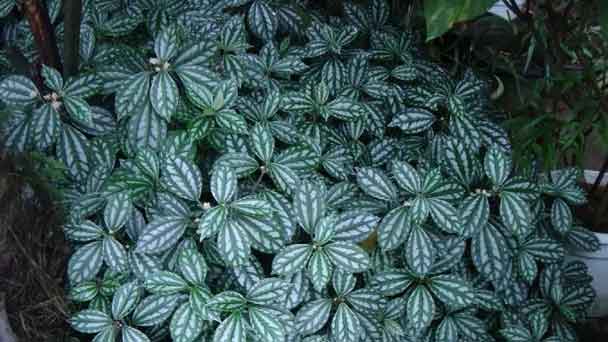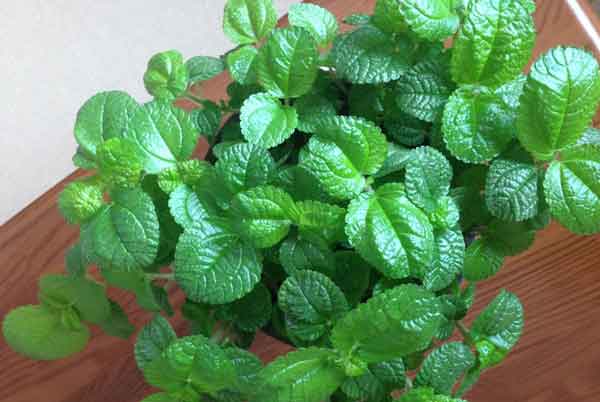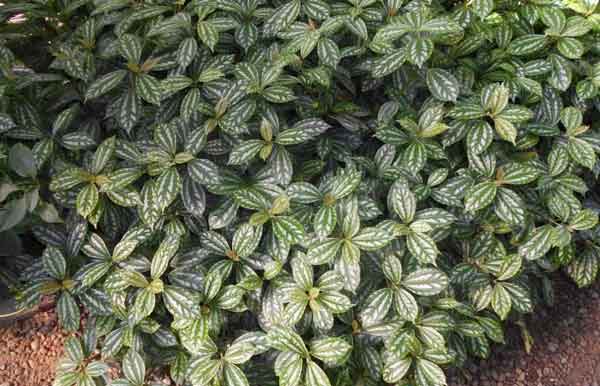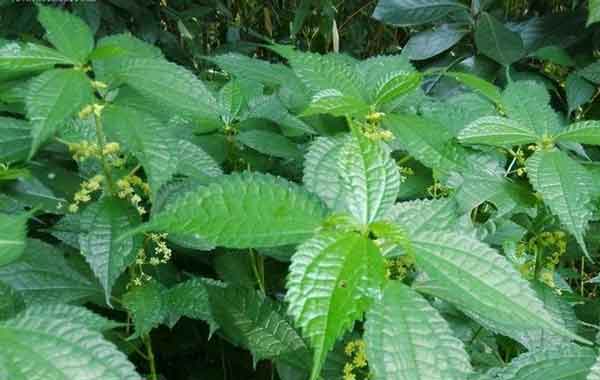Aluminum Plant (Pilea cadierei) Grow & Care Guide
Written by Iris
Nov 13 2021

Aluminum Plant is an evergreen perennial in the family Urticaceae, also known as the Pilea cadierei. Most people usually grow Aluminum Plant as a hanging or tabletop plant. However, Aluminum Plant (Pilea cadierei) can also be kept in a small shell. Aluminum Plant (Pilea cadierei) is usually easy to please and is mainly used for its variegated leaves. (Find more best indoor hanging plants here.)
Read More:
12 Wonderful Evergreen Shrubs for Your Garden
Aluminum Plant usually propagates from cuttings in spring or autumn. Just cut off a section of shoot stem with apex buds directly into the water, about ten days it can give birth to new roots, and the survival rate is very high. You can also use potted plants to grow in water. Wash the roots and then hydroponic. Take a healthy Aluminum Plant, dig it out of the soil, gently shake off excess soil from the roots, and rinse the roots clean with water at a temperature similar to the soil. Then use scissors to cut off all the messy residual roots, diseased roots and rotten roots, leaving only some healthy and robust roots. Soak the pruned roots in dilute potassium permanganate solution for more than ten minutes, and then transplant them in water.
When setting up lighting inside of a vivarium, LED lights will work extremely well. Try to go for cooler colors that resemble a bright, but shaded day. This will make sure the Aluminum Plant is getting all the light it needs, without being harmed. Avoid any type of light that has high levels of UV rays. This will be like placing the fern under direct sunlight.

Prevent this problem by planting in pots with bottom drain holes, using a well-drained soil mixture and watering during the growing season when the top 1/2 inch to inch of soil becomes dry. In winter, only water when the top several inches become dry.
How to Grow Aluminum Plant (Pilea cadierei)Aluminum Plant Propagation with CuttingsAluminum Plant Propagation with DivisionGrow Aluminum Plant In WaterHow to Care for Aluminum Plant (Pilea cadierei)Aluminum Plant Light CareAluminum Plant Soil CareAluminum Plant Water CareAluminum Plant Temperature & Humidity CareAluminum Plant Fertilizer CareAluminum Plant Pruning CareAluminum Plant Pests & Diseases CareAluminum Plant (Pilea cadierei) FAQIs Aluminum Plant Poisonous to Cats?Why Are Parts Of My Aluminum Plant Turning Black And Rotting?Can I Grow Aluminum Plant In An Aquarium?Does An Aluminum Plant Flower?
How to Grow Aluminum Plant (Pilea cadierei)
Aluminum Plant Propagation with Cuttings
Stem-Tip Cuttings of aluminum plant (Pilea cadierei) can be taken at the start of spring when specimens surpass 8cm (3 inches) in height. Either pinch or prune the top 3cm (1.1 inches) of growth with at least to nodes (leaves) - one for foliar growth and the other for root development. Gently remove the lower leaves and set the bottom half of the stem into a moist potting mix. Although we'd recommend using a 'Houseplant'-labelled soil, a general-purpose compost with added perlite and sand will work wonders, too. As long as there is a splash of perlite introduced into the mix, oxygen will flow liberally around the cutting's base to reduce the risk of basal rot. Wrap the plant in a transparent bag with small holes to maintain high humidity, as an absence of roots will result in moisture loss within the Aluminum Plant stem. Provide a bright, indirect location with continual soil moisture to quicken the rate of root development, along with better overall health. Remove the bag once the signs of new growth emerge.Read More:
12 Wonderful Evergreen Shrubs for Your Garden
Aluminum Plant Propagation with Division
This method of Aluminum Plant propagation only really works if your Aluminum Plant is quite bushy and you don't mind taking part of it to form a new Aluminum Plant. But if you do have a big enough Aluminum Plant, then this method is great for anyone who doesn't want to wait for weeks or months for roots and new leaves to grow. With this method of division, you get new plants instantly.- Take your plant out of the pot
- Locate the various natural divisions
- Separate out into sections
- Place each section in fresh potting mix
- Continue normal care
Grow Aluminum Plant In Water
Aluminum Plant usually grows in soil. Hydroponic Aluminum Plant is relatively rare, and many people do not know that this plant can be completely hydroponic. The bright color and silver-white stripes of the Hydroponic Aluminum Plant are more clear, which makes it more beautiful against the clear water and delicate containers.Aluminum Plant usually propagates from cuttings in spring or autumn. Just cut off a section of shoot stem with apex buds directly into the water, about ten days it can give birth to new roots, and the survival rate is very high. You can also use potted plants to grow in water. Wash the roots and then hydroponic. Take a healthy Aluminum Plant, dig it out of the soil, gently shake off excess soil from the roots, and rinse the roots clean with water at a temperature similar to the soil. Then use scissors to cut off all the messy residual roots, diseased roots and rotten roots, leaving only some healthy and robust roots. Soak the pruned roots in dilute potassium permanganate solution for more than ten minutes, and then transplant them in water.
How to Care for Aluminum Plant (Pilea cadierei)
Aluminum Plant Light Care
The Aluminum Plant (Pilea cadierei) is very similar to most rainforest plants when it comes to lighting. It thrives best in bright indirect light. It should not be placed under direct sunlight, or the leaves will end up burning. This makes sense since in its natural habitat larger trees and plants drown out most light far before it could reach the vine's leaves. Make sure that the Aluminum Plant is receiving bright indirect light for at least 4 hours each day. Not enough light will also be damaging to a Pilea Cadierei. If deprived of the light it needs the stems will become leggy and weak.When setting up lighting inside of a vivarium, LED lights will work extremely well. Try to go for cooler colors that resemble a bright, but shaded day. This will make sure the Aluminum Plant is getting all the light it needs, without being harmed. Avoid any type of light that has high levels of UV rays. This will be like placing the fern under direct sunlight.
Aluminum Plant Soil Care
The ideal soil for developing an Aluminum plant is one that drains well and has a peaty foundation. It works well in a wealthy soil medium given it drains and doesn't stay soggy. Many times, directly potting soils are excessively heavy and don't adequately drain, however they're OK to use if your cut on the mix with something such as peat, coarse sand or some lightweight potting mixture. Simply use equal parts of each on your mix to include appropriate drainage. If the soil stays too wet for a long time, root rot can grow which will destroy your Aluminum plant.Aluminum Plant Water Care
Hydrate once the soil's top third dries out, reducing this slightly over the autumn and winter months. Due to their quick growth, which requires a lot of moisture and energy, you may get caught out with under-watering from time to time. Introduce a pebble tray to slow the rates of drying soil by placing a bed of stones on a plastic saucer, followed by a dash of water to increase the local humidity levels. Place the specimen's pot onto the bed of stones, making sure the water level doesn't reach the pot's base for rotting-related issues. Top up the saucer along with watering the specimen as normal. Under-watering symptoms include grey leaves or stunted growth; these issues are commonly down to much sunlight or heat, as well as forgetfulness. Over-watering, on the other hand, include rapidly yellowing leaves, stunted growth, wilting and root rot. These symptoms could be due to a location that is too dark, waterlogging, too little heat and an excess of moisture on the foliage. If you feel that root rot is to blame, click this link for more information.Aluminum Plant Temperature & Humidity Care
When it's comfortable for you indoors, it's most probably comfy for your Aluminum plant. Additionally, it's also going to bear short bursts of temperatures which are somewhat lower and greater. When for any reason you gave your Aluminum Plant a rest from indoor expansion and place it outside, just make sure you put it back indoors until the cold temperatures of winter come knocking on your door.In its native selection, aluminum plants get a constant source of humidity, which has to be replicated within the house. If the Aluminum Plants don't get the right levels of humidity, leaf tips may turn brown. Do not plant the Aluminum plant at an indoor place that's drying like close to a heating or air conditioning vent.
Aluminum Plant Fertilizer Care
During the spring and summer, you can help your Aluminum Plant to grow well by providing it with liquid or soluble fertilizer at least once per month. You should use a balanced fertilizer such as a 7-7-7 or a 20-20-20. There's no need to fertilize the aluminum plant when it slows its growth cycle during the late fall and winter months.Aluminum Plant Pruning Care
You can prune your aluminum plant (Pilea cadierei) every spring to encourage healthy growth and development over the course of the next growing season. Simply trim Aluminum Plant stems back to half their length to keep the plant producing leaves at a healthy rate. Pruning Aluminum Plant annually also keeps the plant from looking too sparse or leggy. As your Aluminum Plant continues to grow, pinch off the flesh of growing stem tips off on a regular basis. By doing this, you help encourage stems to branch out while still appearing compact. Your Aluminum Plant will grow into a leafier, more attractive shape over time.Aluminum Plant Pests & Diseases Care
The aluminum plant is not an invasive species or toxic. However, it does have a few potential threats. Spider mites love this plant. Whiteflies may also pose a problem. Try to wash the mites or flies away with lukewarm water. If the water doesn't get rid of the infestation, use insecticide like neem oil. Besides the pests, look out for gray mold. It's the biggest problem that the aluminum plant may face. With gray mold, the leaves start to develop grayish-brown patches. The leaves will then slowly rot and wither. This is typically caused by overwatering. To get rid of the rot, cut away the infected areas. If the rot has spread, a fungicide may treat the problem.
Aluminum Plant (Pilea cadierei) FAQ
Is Aluminum Plant Poisonous to Cats?
No. Aluminum plant (Pilea cadierei) is considered non-toxic to cats, dogs, and horses per the ASPCA. It’s safe around our furry friends! So if you're looking for a new houseplant, give the aluminum plant a try. The stunning, tropical foliage is well worth the effort, and you’ll love how it looks in your home.Why Are Parts Of My Aluminum Plant Turning Black And Rotting?
The main cause on why leaves and stems of an Aluminum plant begin turning brown to black and begin rotting are too wet conditions. This can be caused by soil that is too heavy, containers without bottom drainage or watering too much.Prevent this problem by planting in pots with bottom drain holes, using a well-drained soil mixture and watering during the growing season when the top 1/2 inch to inch of soil becomes dry. In winter, only water when the top several inches become dry.
Can I Grow Aluminum Plant In An Aquarium?
Although sometimes found being sold in a pet store as an aquarium plant, Aluminum plants are not aquatic and will not survive for long submerged underwater. However, if used as an aquarium plant it will live for only two to three months before dying.Does An Aluminum Plant Flower?
Indoor grown Aluminum plants rarely flower but if they do, the tiny greenish-white flowers are insignificant, as it is all about the colorful foliage.Latest Updated
- Benefits of Bugleweed - 7 Science-backed Health Benefits
- Bugleweed Dangers & Side Effects - Is It Poisonous?
- How to Plant Evergreen Trees - What You Should Know
- When to Plant Evergreens - Grow Guide for Evergreen Trees
- 12 Wonderful Evergreen Shrubs for Your Garden
- 12 Popular Evergreen Plants with Pictures for Beginners
- When And How To Prune A Lilac Bush Like a Pro
- How to Grow & Care for Lilac Vine (Hardenbergia Violacea)
- Japanese Lilac Tree (Syringa Reticulata) Care & Propagation Guide
- Shumard Oak Pros and Cons - What to Know
Popular Articles
- Winter maintenance of Antirrhinum Majus
- How to Grow Terminalia Mantaly Tree
- How to Grow and Care for Crossostephium Chinense
- How to grow Antirrhinum Majus in spring
- Peristeria Elata (Dove Orchid) Profile: Info & Care Guide
- Underwatered Snake Plant (Sansevieria Trifasciata) - Signs And How To Fix
- How to Care for Brazilian Jasmine Plant (Mandevilla Sanderi)
- How to Grow & Care for Graptopetalum Purple Delight in Summer
- Rosa Chinensis (China Rose): Plant Growing & Care Tips
- How to Care for Baby Sun Rose (Aptenia Cordifolia)
